Amped Wireless R20000G, SR20000G, and UA2000: Routers, Repeaters, and Adapters (Oh My!)
by Jarred Walton on June 23, 2012 12:00 AM EST- Posted in
- wireless
- Networking
- 802.11n
- Amped Wireless
Test Location B Results: Performance at Moderate Distances
Our second test location ramps up the difficulty quite a bit—think Nightmare difficulty in Diablo III. Instead of being located in the same room, right next to the router, we’re now down a hallway, past a bathroom, and into the living room. A direct line from the test area (where my HTPC is located) to the router is around 30 feet, while walking is a slightly longer 40 feet. There are two/three sheetrock walls between the router and Location B, depending on how the signal propagates. You can get an idea of the interior layout of my house from the following (poorly put together) floor plan.
As before, we’ll start with a look at signal quality for this test location. I did spend several minutes (or more) with each adapter trying to orient it such that I got a best-case signal, but once we’re in different rooms the variability between testing runs starts to increase dramatically. As an example, one day I measured one set of results (it was a cooler, cloudy day in Washington), and the next day (sunny and warm) I got results that were 20% lower at the exact same location. It’s a bit maddening to say the least, but short of having a large isolated facility where you can rule out all external forms of interference (e.g. temperature, humidity, and other wireless signals) I’m not sure there’s much to be done about it other than to give the standard “grain of salt” caveat.

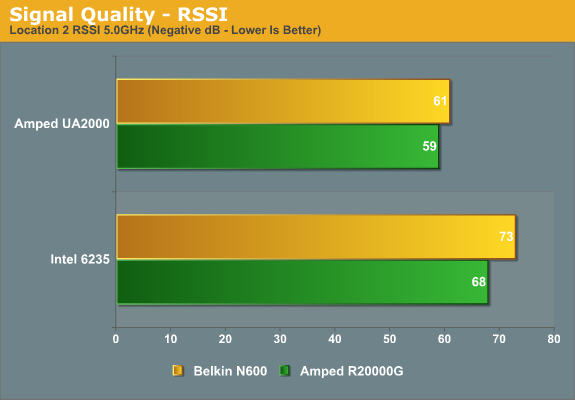
Yet again, Amped delivers on their claims of better signal quality. The R20000G router is 4-12 dB better on the 2.4GHz signal and 2-5 dB better on 5GHz. The UA2000 has similarly large leads, with 3-12 dB better RSSI than the other two adapters. There was at least some correlation between the better RSSI and throughput at Location A; will that hold true with our more demanding test locations? Let’s find out, again starting with the 2.4GHz results.
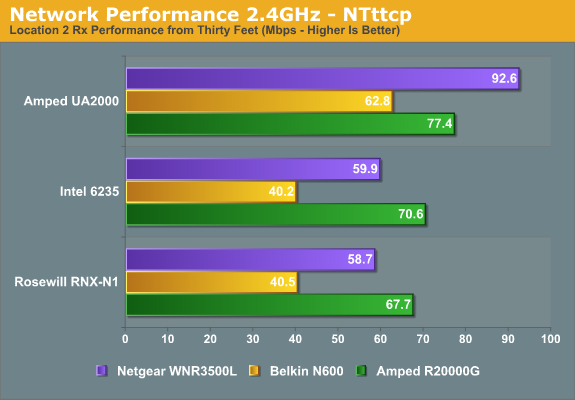
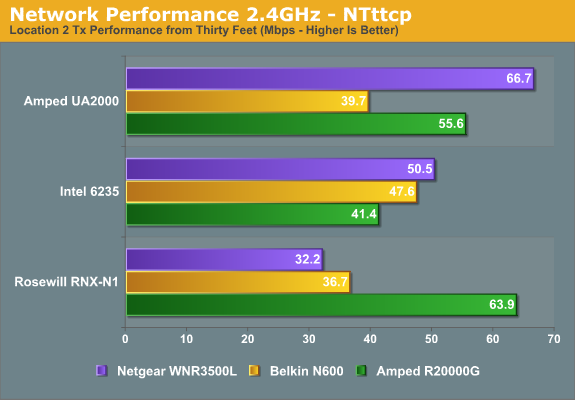
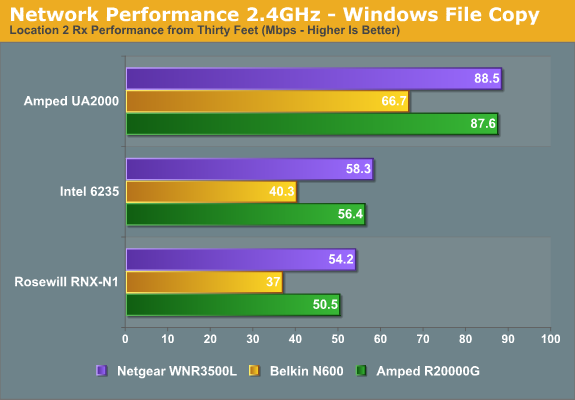

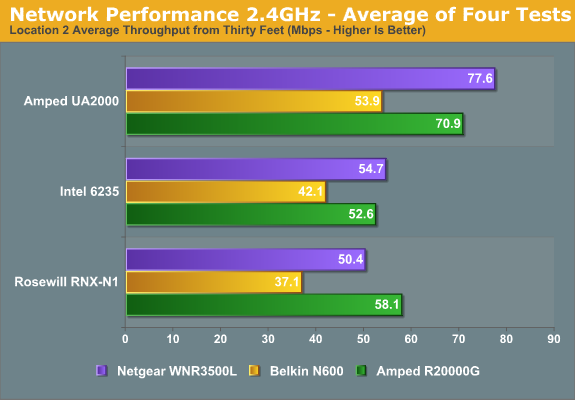
Things get a bit interesting this time around, with some of the adapters performing substantially better when paired with a specific router for some of the tests. Overall, the Netgear router appears to deliver the best throughput in our Rx/Tx file copy results, with the Amped R20000G coming very close. The Belkin router continues to offer substantially lower throughput in most of the charts, with the exception of the NTttcp Tx chart where it places second with two of the adapters. Given the variability of testing at this range, I’d say that the Netgear and Amped routers are more or less equal, and the average throughput across the three adapters agrees with that: the Netgear comes out 1% ahead.
The story for the adapters is far more clear cut, with the UA2000 delivering substantially better throughput than the other two adapters. There’s only one test results (NTttcp Tx) where the UA2000 places second to the Rosewill adapter, and the Windows Copy test doesn’t agree with that result. Average performance with the UA2000 is 35% better than the Intel 6235 across the three routers, and 40% better than the Rosewill RNX-N1. If you have a location with a single PC where you’d rather not run an Ethernet cable, the UA2000 at least approaches 100Mb Ethernet speeds over 2.4GHz wireless.

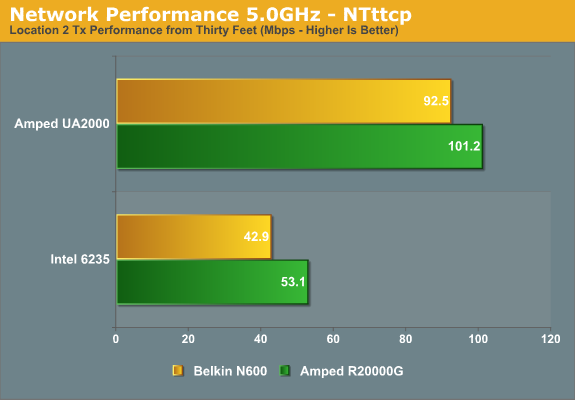
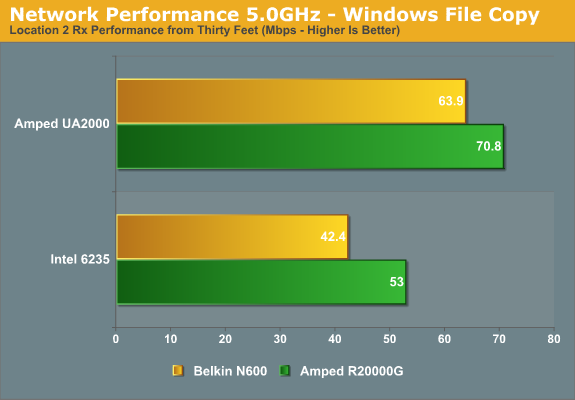
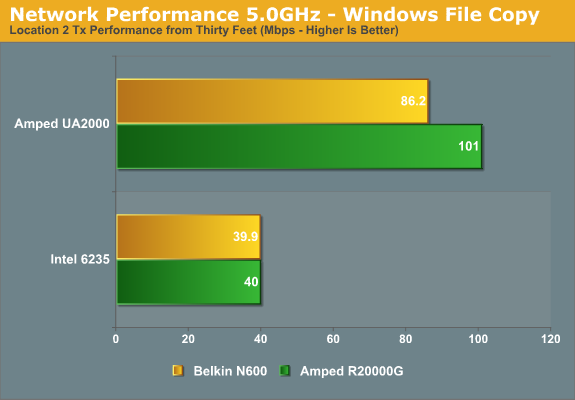
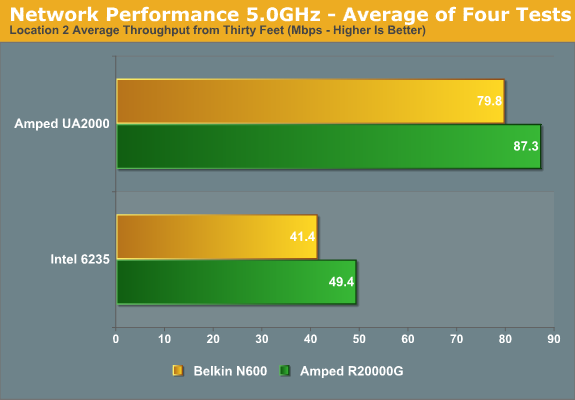
The 5.0GHz results echo the above, only this time the closest we get is a tie in NTttcp Rx rates with the UA2000. For all other comparisons, the R20000G router delivers slightly better performance than the Belkin N600, and the UA2000 adapter basically wipes the floor with the Intel 6235. Of course, directional wireless isn’t nearly as useful in something like a laptop where you’re moving around and unlikely to always end up facing the router, but for stationary PCs you can get excellent performance. On average, the Amped UA2000 is 84% faster than the Intel 6235 while the Amped R20000G is 13% faster than the Belkin N600.











28 Comments
View All Comments
tonyt87 - Saturday, June 23, 2012 - link
Cisco/Linksys switched to Marvell chipsets with the 4200v2 and 4500, the original 4200 uses Broadcom.arthur449 - Saturday, June 23, 2012 - link
I used the SR10000 repeater recently to provide a solution for weak / non-existent signal anywhere beyond the far end of their apartment where they kept all of their computer equipment. I positioned the repeater in a higher/more centralized location and they get great reception to it.This is after I made absolutely sure they could not stand to run an ethernet cable/use powerline networking or reposition their overpriced fruit-branded wireless router to a new (higher) location rather than keeping it beneath a desk. Apparently, they have a fear of wires, yet hate unreliable connections. *shrug*
Anyhow, the repeater gives them reception in the places where it was simply impossible and didn't create any additional unsightly cords.
I've only run into one problem: When the fruit-branded wireless router loses power, the SR10000 repeater freaks the *$(@ out and does not automatically reconnect to the fruit-branded network when it comes back online. While I'm certain a static IP for the wireless repeater would fix this, the client can't remember the fruit-branded router's admin password and a full reset is strictly forbidden.
ShinyLeaf - Saturday, June 23, 2012 - link
I have this same repeater (SR10000) and a non-fruit branded router with the same problem. I tried to switching to static IP and it doesn't fix the problem.Anytime the router / access point loses power, or the repeater loses the wireless connection for a sec (microwave interference, etc), the repeater just craps out and I need to unplug/plug-in to get it to reconnect.
Probably a firmware issue, but there hasn't been any update in 6 months.
irev210 - Saturday, June 23, 2012 - link
There is a bigger comparison over at smallnetbuilder - not really that impressive:http://www.smallnetbuilder.com/wireless/wireless-r...
Pretty sad, really.
mevans336 - Saturday, June 23, 2012 - link
I read the Smallnetbuilder review and came away with the same opinion.Their "coverage" claims reek of sleazy marketing hype to confuse the average consumer. "Oh look, we cover 10,000 bajillion feet!" when in actuality, their coverage is no better than any other wireless router on the market.
JarredWalton - Saturday, June 23, 2012 - link
Note that the smallnetbuilder review is for the R10000G, so there's no 5GHz support. Looks like 2.4GHz support is roughly the same, given our different test locations, though I was able to connect at the worst-case location without trouble. Also note that smallnetbuilder only tests with one wireless adapter on the newer routers, the Intel Ultimate-N 6300. If you couldn't tell, in my experience the choice of wireless adapter can make a very large difference in some tests.That's the hard thing with wireless testing: change any variable (router, adapter, time of day, weather, drivers, test laptop, positioning, etc.) and you can't guarantee the results are directly comparable. Ideally, I'd want to do a large roundup of at least ten different wireless adapters and test those with a couple different routers -- and if you really want to be apples-to-apples, you'd need to test them all in the same laptop or use a PCI card. From that, you can determine which adapters work best in general. Then take the top three adapters and test every router with those adapters, and you should be able to determine which routers work the best.
That, incidentally, is a TON of work, assuming you can even get all the hardware to test with. Given the amount of testing, you'd be looking at different adapters/routers on different days with different weather, so you'd probably need to test each adapter/router combination at least twice (e.g. several days apart) to verify there's no massive change in performance, and if there is then test a third time. I'm not sure if there's enough value in doing that much testing, so the result is more "rough estimate" type reviews, like what I've done.
Olaf van der Spek - Saturday, June 23, 2012 - link
Isn't DD-WRT (development) dead anyway?JarredWalton - Saturday, June 23, 2012 - link
I don't believe so; you can get a build dated March 15, 2012 for the ASUS RT-N66U for example. There are also similar tools out there (OpenWRT, MyOpenRouter--Netgear only on that one). I think it would be best to state that the set of new hardware being supported is very limited, so if you want DD-WRT support you need to shop with that intention.Olaf van der Spek - Sunday, June 24, 2012 - link
Latest stable release has been v24 SP1 (Build10020) and Latest development release has been v24 preSP2 (Build13064) for years.A build dated March 15, 2012 doesn't mean that much.
Is there a comparison between DD-WRT and OpenWRT available somewhere?
blindbox - Monday, June 25, 2012 - link
You should take a look at their source revisions. For example, OpenWrt just hit their 32000th revision about a month ago.Anyway, here's where you can see progress.
OpenWRT https://dev.openwrt.org/browser
DD-WRT http://svn.dd-wrt.com/browser
Last commit for OpenWRT was 20 hours ago. For DD-Wrt, it was 50 minutes ago.
DD-WRT does provide snapshot builds but I don't know why they've stopped releasing stable builds altogether. OpenWrt at least has their somewhat yearly stable releases.